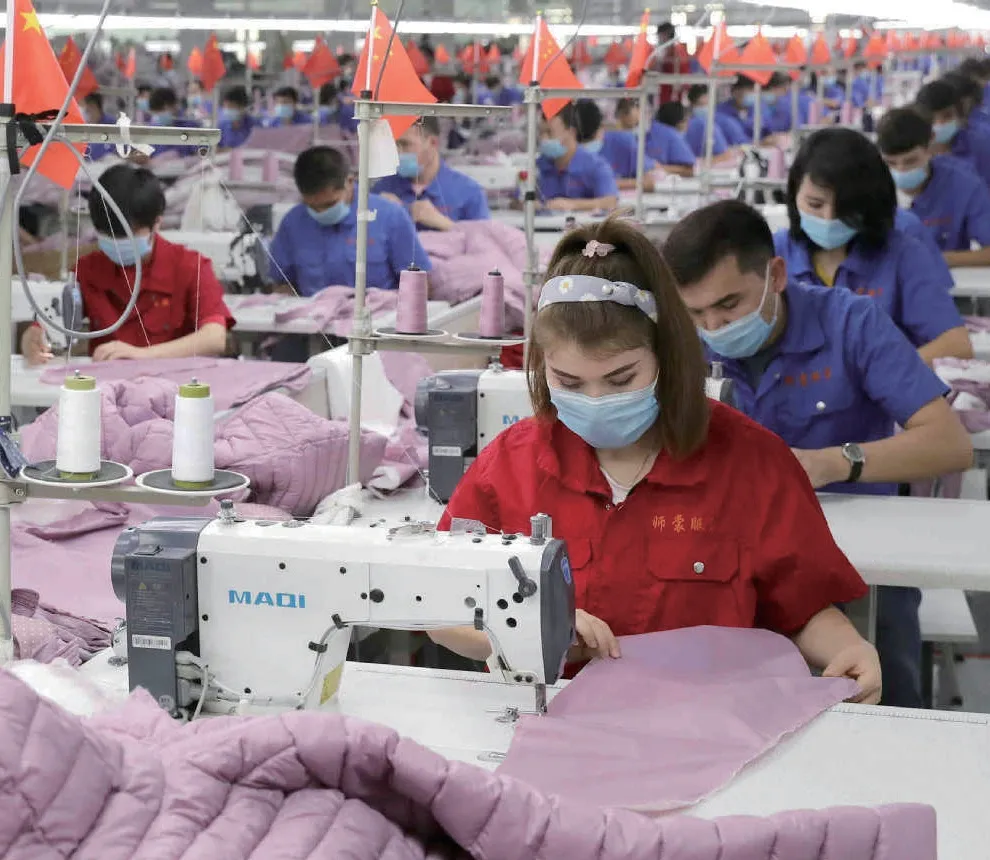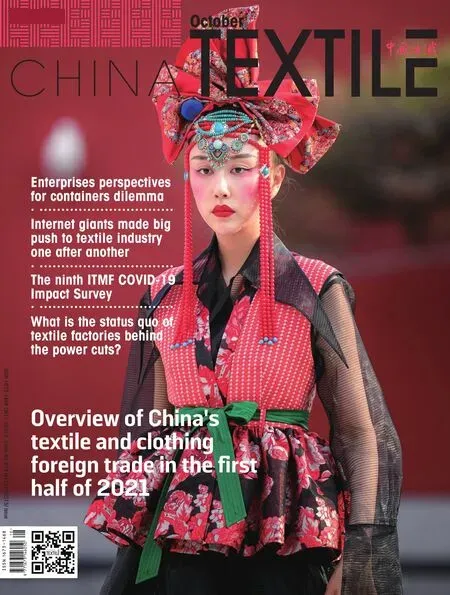Briefing on economic operation of China’s garment industry in Aug.
Edited by Zhao Xinhua
Thee recovery of China’s garment industry has weakened, and the growth rate of major economic indicators such as production, sales, investment and benefit has dropped slightly affected by factors such as the complex and severe international environment, the impact of the domestic pandemic and the rising base in the same period last year, especially the year-on-year growth rate of retail sales of garment goods of units above designated size in August turned negative for the first time in the year. Although rising costs have brought more challenges to the continuous and stable recovery of corporate profits, the main indicators of the industry still maintain rapid growth, the production and operation conditions of enterprises continue to improve, the economic operation of China’s garment industry continues to recover, and the vitality and resilience of the industry’s development will continue appear.
Apparel production continues to rebound
According to the data of the National Bureau of Statistics, from January to August 2021, the industrial valueadded of enterprises above designated size in China’s garment industry increased by 9.9 percent year-on-year, 21.3 percentage points higher than the same period last year, 0.5 percentage points lower than that from January to July, with a two-year average decline of 1.3 percent. The garment output of enterprises above designated size reached 15.236 billion pieces, up 12.85 percent year-on-year, 24.8 percentage points higher than that of the same period last year, 2.93 percentage points lower than that from January to July, and 0.3 percent lower on average in two years.
In terms of the output of major garment categories, taking January-August 2019 as the base period, the production scale of knitted garment increased slightly compared with that in the pre-pandemic period, while the output of woven garment still showed negative growth on average in two years, and the output of down garment and shirt showed a more obvious decline. According to the National Bureau of Statistics, from January to August 2021, the output of woven garments of enterprises above designated size in the garment industry was 6.099 billion pieces, with a year-on-year growth of 6.69 percent and a two-year average decline of 3.5 percent. Of this, the output of down garments, suits and shirts increased by 1.88 percent, 5.59 percent and 1.87 percent respectively, the two-year average decreased by 16.5 percent, 4.4 percent and 17.4 percent respectively; the production of knitted garments reached 9.136 billion pieces, up 17.37 percent year-on-year and up 2.0 percent on average over the past two years.
Domestic sales growth slowed down significantly
In August, the domestic sales market of garment still maintained a recovery growth trend, but the domestic sales growth slowed down. Thee pandemic and flood in local areas are the main reasons for the rapid fluctuation of short-term garment domestic sales growth rate. In addition, the policy adjustment of some industries led to the rise of youth unemployment rate in major cities and further inhibited summer wear consumption, and the base of the same period last year turned to positive growth, and other factors, which had a certain impact on the growth rate of domestic garment sales.
Thee growth rate of physical channel sales declined significantly, with retail sales turning negative in August for the first time. According to the data of the National Bureau of Statistics, from January to August of 2021, the retail sales of garment goods of units above designated size in China totaled 615.4 billion yuan, up 27.5 percent year-on-year, down 5.7 percentage points compared with January to July, and up 2.9 percent in two years on average. Affected by pandemic in China and fewer shopping trips, the retail sales of garment goods of units above designated size decreased by 7.6 percent year-on-year in August, with an average decline of 1.8 percent in the past two years. According to the data of China National Commercial Information Center, the retail sales and volume of garment of national key large retail enterprises in August decreased by 9.35 percent and 17.57 percent year-on-year respectively, and the accumulative growth rate was 5.32 and 6.6 percentage points lower than that of January-July respectively.

Thee growth rate of online channels is slightly better than that of oラine channels. According to the National Bureau of Statistics, from January to August 2021, the online retail sales of wearables grew 19.4 percent yearon-year, 18.9 percentage points higher than the same period last year, 2.2 percentage points lower than the January-July period, with a two-year average growth of 9.9 percent.
Exports maintained fast growth
Driven by factors such as the recovery of international market demand and the return of overseas orders, China’s garment export continued the rapid recovery since the second half of 2020 and maintained substantial growth. According to the data of China Customs, from January to August of 2021, China’s total export of garment and garment accessories reached USD 105.695 billion, with a year-on-year growth of 28.1 percent and a two-year average growth of 5.6 percent. Thee growth rate of garment export slowed down month by month, with a monthly growth rate of 8.7 percent in August, and the growth rate of market demand gradually returned to normal.
Among the top 10 main garment export markets, China’s garment export to the other nine countries and regions showed rapid growth at different ranges except for the UK, which saw a slight decrease of 0.77 percent. Of this, China’s garment export to the United States, the European Union, Japan and ASEAN increased by 46.90 percent, 17.99 percent, 10.02 percent and 22.39 percent year-on-year respectively, accounting for 59.03 percent of the total garment export. Taking January-August 2019 as the base period, China’s garment export to Japan and Russia decreased by 1.64 percent and 11.25 percent on average in two years, while its garment export to the United States, the European Union and ASEAN increased by 6.57 percent, 3.80 percent and 16.03 percent on average in two years.
Operation quality and efficiency are gradually improved
Economic performance continued to recover. According to the data of the National Bureau of Statistics, from January to August 2021, there are 12,520 enterprises above the designated size in China’s garment industry (annual main business income of 20 million yuan or more), realizing the operating revenue of 905.589 billion yuan, with a yearon-year growth of 9.58 percent, the growth rate is 23.94 percentage points higher than the same period last year, and 1.46 percentage points lower than that from January to July; the total profit was 39.618 billion yuan, up 9.53 percent year-on-year, 35.16 percentage points higher than the same period last year, 0.28 percentage points lower than the January-July period. Compared with the same period in 2019, the two-year average decline in operating income and total profit of the apparel industry was 3.1 percent and 9.7 percent respectively, which was still in the recovery stage.
The quality of industry operation is obviously better. From January to August, the percentage of loss-making enterprises above designated size in the garment industry was 24.69 percent, 3.77 percentage points narrower than the same period last year; the cost of operating income of 100 yuan was 94.96 yuan, a year-on-year decrease of 0.15 percent; total assets turnover and finished products turnover were 1.22 times/year and 12.21 times/year respectively, 6.33 percent and 6.87 percent faster than last year respectively; the operating income margin was 4.37 percent, essentially unchanged from a year ago and 0.11 percentage points higher than January-July.
Industry investment rebounded cautiously
According to the data of the National Bureau of Statistics, from January to August 2021, the completed fixed asset investment of China’s garment industry increased by 4.8 percent year-on-year, the growth rate was 39 percentage points higher than the same period of last year, 0.4 percentage points lower than that from January to July, and 9.1 and 10.9 percentage points lower than the overall level of textile industry and manufacturing industry. Thee completed fixed asset investment in the garment industry fell by an average of 17 percent over the two-year period compared to the same period in 2019, and has yet to recover to pre-pandemic levels.

